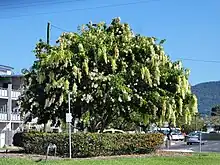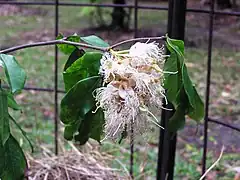| Cascading bean | |
|---|---|
 | |
| Scientific classification | |
| Kingdom: | Plantae |
| Clade: | Tracheophytes |
| Clade: | Angiosperms |
| Clade: | Eudicots |
| Clade: | Rosids |
| Order: | Fabales |
| Family: | Fabaceae |
| Genus: | Cynometra |
| Species: | C. lenticellata |
| Binomial name | |
| Cynometra lenticellata (C.T.White) Rados. (2019) | |
| Subspecies[1] | |
| |
| Synonyms[1] | |
|
Maniltoa lenticellata C.T.White (1927) | |
Cynometra lenticellata is a flowering tropical tree in the family Fabaceae. It is native to tropical semi-deciduous rainforest and gallery forests in northern Queensland, some of the Torres Strait Islands, and New Guinea. Common names include: silk handkerchief tree, cascading bean, and native handkerchief tree.

Cynometra lenticellata can grow up to 22 m (72 ft) tall but, more commonly, only reaches 10–12 m (33–39 ft). It has compound leaves with 2-4 pairs of leaflets. New leaves are folded inside dull red bracts and then released in a spectacular cascade of white foliage. The fruity-scented flowers which appear in north Queensland in September to October have 3 to 5 white-cream petals, and may be pollinated by marsupials or bats. They produce a brown pod 25–70 mm long by 18-50mm containing one brown seed in November to March. It is a favoured garden tree.[2][3]
"Cynometra lenticellata var. villosa Verdc. from New Guinea differs from var. lenticellata in having ovaries with dense, persistent hairs." Quoted from:
Footnotes
- 1 2 Cynometra lenticellata (C.T.White) Rados. Plants of the World Online. Retrieved 17 August 2023.
- ↑ Endress and Steiner-Gafner (1996), p. 262.
- ↑ Beasley (2009), p. 111.
References
- Beasley, John. (2009). Plants of Cape York: The Compact Guide. John Beasley, Kuranda, Qld., Australia. ISBN 978-0-9806863-0-2.
- Endress, Peter K. and Brigitta Steiner-Gafner. (1996). Diversity and Evolutionary Biology of Tropical Flowers. Cambridge University Press. ISBN 0521565103, ISBN 978-0-521-56510-3